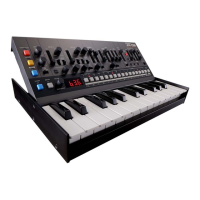
Do you have a question about the Roland JX-08 and is the answer not in the manual?
| Product type | Digital synthesizer |
|---|---|
| Product color | Black |
| Sound effects | Chorus, Compression, Delay, Overdrive, Phaser, Pitch shift |
| Backlight color | Red |
| Backlight buttons | Yes |
| Sound effects quantity | 12 |
| Keyboard number of keys | - |
| Preset programs quantity | 256 |
| Reverberation effects quantity | 4 |
| Battery type | AA |
| Power source type | Battery, USB |
| Number of batteries supported | 6 |
| USB ports quantity | 1 |
Describes the function of the ARPEGGIO, NOTE, and SEQ buttons for mode selection.
Details essential navigation and editing controls like START, MENU, VALUE, and number buttons.
Explains the controls for the Low Frequency Oscillator (LFO) effect and its parameters.
Details controls for the Direct Digital Oscillators affecting sound character and pitch.
Explains controls for adjusting volume levels of different sound components.
Details controls for the Voltage Controlled Filter, altering the tone's sound.
Describes controls for the Voltage Controlled Amplifier, adjusting volume.
Explains controls for envelope generators affecting pitch and filter changes.
Details the portamento effect for smooth pitch transitions between notes.
Guides on applying and configuring built-in effects like Chorus and Reverb.
Describes the function of the external clock input for synchronization.
Overviews all physical connectors and power controls on the rear of the unit.
Explains how to navigate and select sound patches by group and bank.
Describes how to switch between the unit's two distinct sound generator parts (A and B).
Explains how to activate DUAL mode for layered sounds.
Details how to divide the keyboard to play different parts on separate key ranges.
Guides on how to adjust arpeggio parameters and patterns.
Explains how to select and recall saved sequencer patterns.
Instructions on how to play back selected sequencer patterns.
Details how to adjust the tempo for sequencer patterns.
Guides on how to input notes to create new sequencer patterns.
Explains how to input notes for steps beyond the initial 16-step page.
Describes how to choose PART A or PART B for recording sequence data.
Instructions for connecting notes using the tie input function.
Guides on inputting notes step-by-step in the sequencer.
Explains how to record performances directly into the sequencer.
Details how to adjust note velocity and gate time in the sequencer.
Covers general sequencer settings and utility functions.
Details parameters for configuring individual sound parts.
Explains settings related to keyboard touch, transpose, and split point.
Covers MIDI channel, sync, and transmission settings.
Details system-wide settings like auto-off and tuning.
Explains utility functions like initializing patterns and tones.
Guides on how to reset the unit to its original factory defaults.
Explains how to operate the unit using battery power.
Details configuration options for Chorus and Multi-FX.
Details the settings for the Reverb effect.